Random Notes Of Boston: Ch 3 (original) (raw)
II.
AVENUES OF THE NEW CITY.
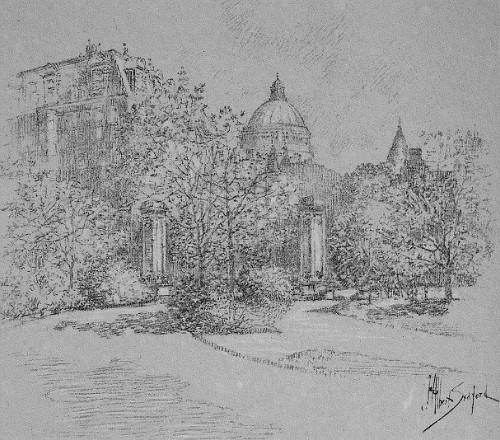
THE WESTLAND AVENUE ENTRANCE OF THE FENWAY; BEYOND,
THE DOME OF THE FIRST CHURCH OF CHRIST, SCIENTIST.
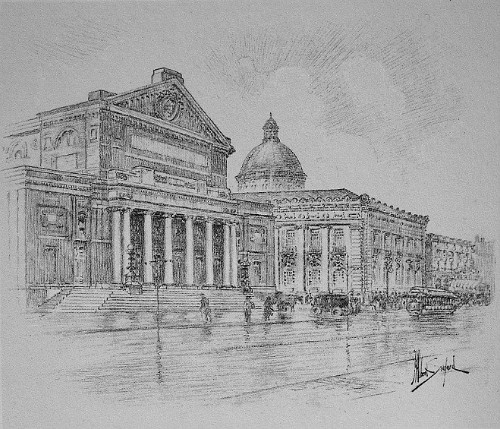
SYMPHONY HALL, HUNTINGTON AVENUE; HORTICULTURAL HALL;
BEYOND, THE DOME OF THE FIRST CHURCH OF CHRIST, SCIENTIST.
IN many towns, the avenues run at right angles with the streets, or in some way differentiate from them by direction or arrangement. This is not so in Boston, where any street may be an avenue, or any avenue a street, according to the whim of its sponsors. Thus, character in avenues, as well as in streets, is individual, rather than collective. Observe Harrison avenue, where odd Oriental foods are served to be eaten with chop-sticks, and the "yellow peril" is more gastronomic than economic: Hunt�ington avenue, from Trinity Crossing, Copley square, to Brookline, with more than its share of show-places, Commonwealth avenue and its uncommonly wealthy residents; and Massachusetts avenue, in apparent contravention of the rules of the game, crossing the others at right angles in its journey through Dorchester, Roxbury and the Back Bay, and bridging the Basin to Cambridge, whence, after nosing about Harvard College, it disappears among the distant hills of Arlington -- a well educated, broad�minded and cosmopolitan highway, though devious. Then regard Beacon, Marlboro, Newbury and Boylston streets, all seemly and well-conducted routes, which, if the term "avenue" connoted any distinction, should bear that euphonious title. In the intended meaning of the chapter head, these fall naturally under the classification of avenues. If you were a sight-seer, Huntington avenue would keep you busy for a day or a month, according to the thoroughness of your purpose and persistence, by reason of the numerous notable institutions along the greater part of its length. Yet its name dates back only to 1864, five years before the great Peace Jubilee and Musical Festival, the vast Coliseum of which overlooked the avenue at its cityward end, at Copley square.
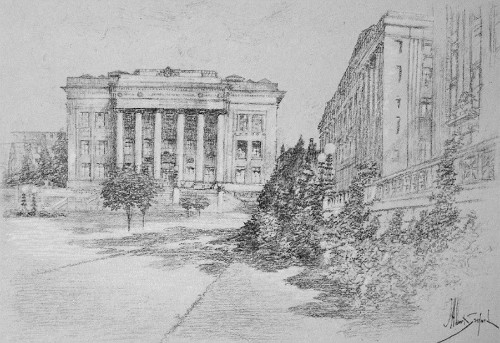
THE HARVARD UNIVERSITY SCHOOL OF MEDICINE, LONGWOOD AVENUE.
The Peace Jubilee, celebrating a reunited, if not reconstructed country and the prevalence of national peace, was conceived by the late P. S. Gilmore, the famous band master. The Coliseum, a temporary structure of wood, stood where later the old Art Museum was built, and where today stands the Copley-Plaza hotel. Photographs show that the immense building, three hundred feet wide by five hundred feet long, overlooked a network of newly graded streets and unfilled building lots. It shel�tered fifty thousand persons. Ten thousand sang in the trained festival chorus, and a thousand musicians composed the orchestra and bands. Pres�ident Grant was the most distinguished of the guests, and Doctor Oliver Wendell Holmes wrote a hymn of peace for the occasion.
The musical program was made up largely of standard, classical works, and, according to the newspaper reports, was very beautifully rendered. Try to imagine ten thousand persons singing "The Anvil Chorus," "The Star Spangled Banner" and "America," each with "Organ, Orchestra, Military Band, Drum Corps, Bell and Cannon Accompani�ment."
Along Huntington avenue lies the "Quartier Latin" of Boston, a sort of expurgated Montmartre, a very real and red-blooded world of student life. Here lodge the boys and girls of the schools and studios. The Institute of Technology, Boston Uni�versity, the medical departments of Harvard and Tufts, the Conservatory of Music and lesser insti�tutions where one may study to become an artist, an orator, an actor, or a virtuoso, contribute a floating population and an agreeable atmosphere of youth and ambition.
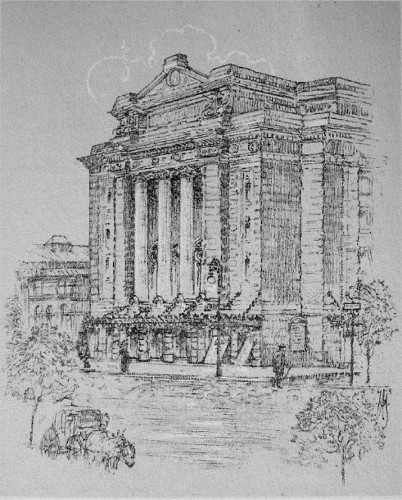
THE BOSTON OPERA HOUSE, HUNTINGTON AVENUE.
One might speak, accurately enough, of a "Uni�versity of Huntington Avenue," with its narrow, asphalt campus. It owns no blanketing traditions, but a sunny, hopeful Bohemianism, perfectly com�patible with baths, barber shops and mannerly behavior. With the advantages of the great Library, the Art Museum, the Symphony, the Opera and countless freely opened doors to recitals and lectures, this "University" makes the educating process an agreeable pastime instead of a period of drudgery. It is characteristic of Boston that unenrolled thousands, of all ages and classes, profit by its tuition with delight, not only on weekdays but on Sundays as well. From the corner of Tremont street, along Boylston street and out Huntington avenue nearly to Brookline Village, one finds almost every second portal ready to swing inward to the explorer for truth, and though you seek theology or theosophy, medicine or melody, religion or relaxation, you will decipher "welcome," woven under foot or shining overhead, and someone inside who knows more about the subject than you do. For further particulars, consult the Evening Transcript's "Going on To�night" tabulation.
And now consider the Symphony, an orchestra of master soloists, housed in a great building whose simple dignity and reserve within and without render democratic the richness of its design; consider the Symphony, incomparable galaxy, playing like condescending angels, at the annual spring "Pops," and alternating Wagner and Cohan, so that no taste may go away unappeased. Through a thin blue fog of tobacco you see the distinguished conductor bow to a storm of applause, while waiters scurry among the tables, and women of gentle breeding peerdown at the throng from the high balconies.
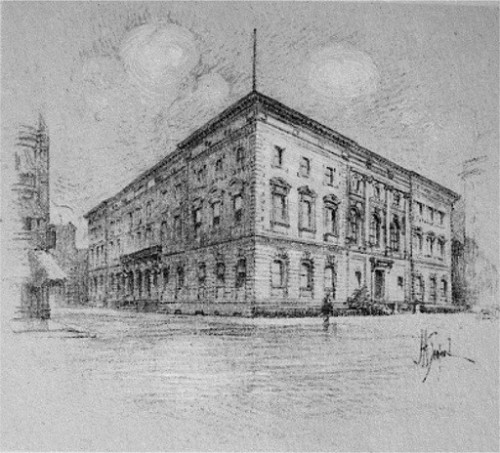
THE NEW ENGLAND CONSERVATORY OF MUSIC, HUNTINGTON AVENUE; ENROLLS THREE THOUSAND PUPILS ANNUALLY.
"THE NURSERY OF OPERA"; AMONG ITS GRADUATES ARE MESDAMES NORDICA, HOMER, AMSDEN, AND MANY OTHER AMERICAN ARTISTS OF NOTE.
For the regular Symphony concerts, season tickets for preferred sittings fetch great prices at auction, but the same concerts are available for those of moderate means who crave music of the classic sort. The orchestra is composed of one hundred salaried performers, recruited from all over the world; it is in fact, the largest permanent organization of its kind. The season of 1913-1914 will be the thirty�-second of its history.
Old Jed Prouty, of tender memory, used to recall the day when Little Eva couldn't die in Bucksport because the opry house was full o' hay. Similarly, the heroes and heroines of grand opera were obliged, up to the year 1909, to limit their activities, moribund or otherwise, to an occasional period of three weeks in Boston and to the inadequate accommodations of an ordinary theatre, or to surmount, as best they might, the acoustic difficulties of Mechanics Hall. But with the building of the new Opera House on Huntington avenue, came the organization of the Boston Opera Company and the inauguration of an annual season of opera by artists of recognized talent, in Italian, French and German. Public spirit has made opera in Boston possible, but music lovers have especially to thank Mr. Eben D. Jordan, whose gen�erosity, like that of Colonel Henry L. Higginson touching the Symphony, has smoothed the roughplaces and rendered financial profit a negligible con�sideration.
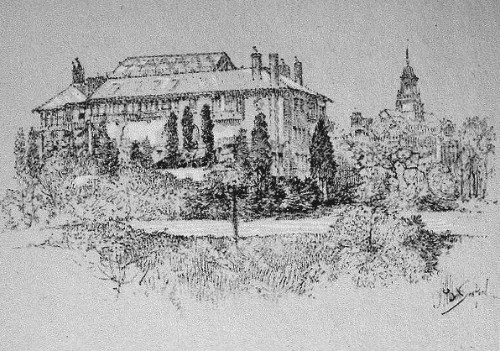
FENWAY COURT, THE ISABELLA STUART GARDNER MUSEUM OF ART.
And so the march across the dreary flats of the Back Bay has been and will continue to be an advance of the Boston spirit, typified in brick and stone and asphalt. The softening touch of time is already in some evidence, particularly when you contemplate the churches. The venerable society of the South Church, formed in 1669, after worshipping for over a century in the beloved Old South Meeting House at Milk and Washington streets, and forced by the normal increase of its years, built its present home on Boylston street in 1875. Something of the dignity of its age seems to have been imparted to the graceful lines and soft, vine clad arches of the newer structure. It is in this visible and tangible quality of the Boston spirit, made manifest in the monu�ments destined to speak for us to the generations of the future, that our individuality is to be preserved.
Let them say of us that we builded, if not better than we knew, at least as well, and surely with loving regard for the Boston of other days, both past and yet to dawn.